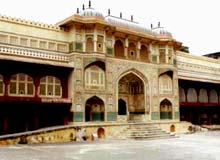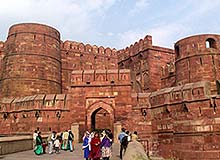
These magnificent forts can not be described in words as they will look too small in front of splendor of forts that beautify India. Some prominent forts of Rajasthan are Amber fort, Chittorgarh fort, Jaisalmer fort, Lohagarh fort, Bikaner fort and Jaigarh fort. Delhi, the capital of India also boasts of some great forts. Some of the notable forts of Delhi are the Red fort, Purana Quila and the Tughlaqabad fort. These grand forts clearly depict the glory of Indian majestic past. There are many other forts of importance in India. Some of the most notable are the Red fort, Agra, the Gwalior fort and the Junagarh fort
Agra Fort
The majestic Agra fort was built by the great Mughal emperor, Akbar in 1565-75. The Agra fort contains numerous impressive structures like the Jahangir Mahal, Khas Mahal, Diwan-i-Khass, Diwan-i-Am, Machchhi Bhawan and Moti Masjid. The Agra fort is enclosed by a double battlemented massive wall of red sandstone. This wall is about 2 km in perimeter and is interrupted by graceful curves and lofty bastions. Many of the buildings inside the Taj Mahal were pulled down by Shah Jahan, who erected some new ones. The Agra fort has four gates, of which the Delhi Gate is the most impressive.

The fort of Agra stands about 2 km from the Taj Mahal on the same bank of River Yamuna. The Agra fort stretches for almost 2.5 km. At present the visitors are allowed to enter the Agra fort from the Amar Singh Gate. The Amar Singh Gate leads to the courtyard. The magnificent Diwan-I-Am (Hall of Public Audience) is on the right side. A little further lay the royal pavilions (containing Nagina Masjid and Mina Masjid), palaces (Macchi Bhavan, Khas Mahal, Shish Mahal, Shah Jahani Mahal) and the Zenana Mina Bazaar. It is interesting to note that to rooms cool, the walls were made hollow and filled with running water. A very nice view of the Taj Mahal can be had from the balconies in the pavilions.
Shah Jahan was imprisoned in the Agra fort by his son Aurangzeb. Shah Jahan spent his last days in the Musamman Burj of the Agra fort. The Musamman Burj is located on the left of the Khaas Mahal. It is a beautiful octagonal tower with an open pavilion. With its openness, elevation and the benefit of cool evening breezes flowing in off the Yamuna River. From the Musamman Burj one has the best view of the Taj Mahal.
No comments:
Post a Comment